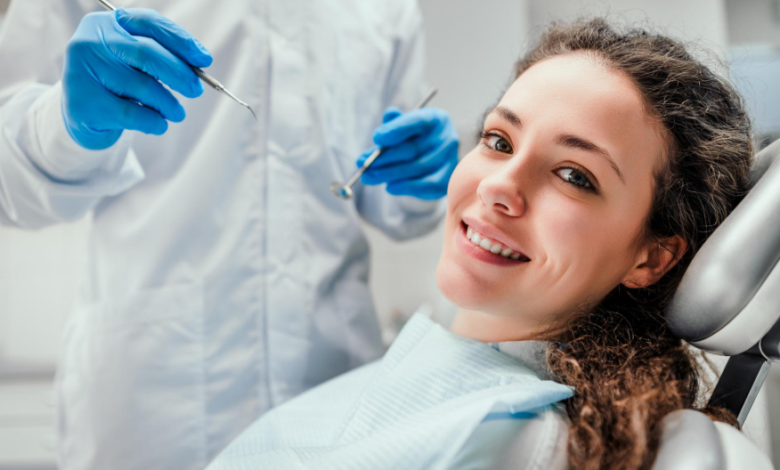7 Natural Ingredients That Actually Whiten Your Teeth

While professional treatments from a cosmetic dentist in London offer transformative results, natural ingredients can provide a gentle, cost-effective way to maintain whiteness between visits. This article explores seven natural ingredients that have shown promise in whitening teeth, supported by scientific insights and practical guidance. Importantly, these remedies should be used cautiously and in conjunction with professional dental advice to ensure safety and efficacy.
Dr. Sahil Patel, expert in cosmetic dentistry in London at MaryleboneSmileClinic, offers his perspective on natural whitening methods: “Natural ingredients can be a useful adjunct to professional dental care, particularly for surface stain removal. However, they should never replace regular dental check-ups or professional whitening treatments, as overuse or improper application can harm enamel or gums. Always consult a dentist to ensure your oral health is not compromised.” His advice underscores the importance of balancing natural remedies with professional oversight to achieve a safe and radiant smile.
Tooth Discoloration
Tooth discoloration arises from various factors, including dietary habits, lifestyle choices, and natural ageing. Extrinsic stains, which affect the tooth’s surface, are often caused by consuming staining substances like coffee, tea, red wine, or tobacco. Intrinsic stains, embedded deeper within the tooth, may result from medications, trauma, or genetics. Enamel, the hard outer layer of teeth, protects the yellowish dentin beneath. When enamel thins due to acid erosion or abrasive practices, dentin becomes more visible, leading to a yellower appearance. Understanding these causes is crucial for selecting appropriate whitening methods, whether natural or professional.
Natural remedies primarily target extrinsic stains, as they lack the potency to address deeper discoloration. A cosmetic dentist in London can assess the type of staining during a consultation, recommending tailored solutions. For instance, professional whitening treatments use stronger agents like hydrogen peroxide, which penetrate deeper than natural ingredients. However, incorporating natural remedies into a daily routine can help maintain a brighter smile and reduce the frequency of professional treatments.
See also: Telehealth Services for Remote Medical Consultations
Baking Soda: A Gentle Abrasive
Baking soda, or sodium bicarbonate, is a well-known natural ingredient for whitening teeth due to its mild abrasive properties. Its alkaline nature helps neutralise acids in the mouth, reducing plaque buildup and surface stains. Studies suggest that baking soda can effectively remove stains caused by coffee or tea when used sparingly. To apply, mix a small amount of baking soda with water to form a paste, brush gently for one to two minutes, and rinse thoroughly. Overuse, however, can erode enamel, so it should be limited to once or twice a week.
Many whitening toothpastes incorporate baking soda for its polishing effect, but homemade pastes offer a cost-effective alternative. The key is moderation, as excessive abrasion can weaken enamel, exposing dentin and paradoxically increasing yellowness. Consulting a cosmetic dentist in London before starting any abrasive regimen ensures that the enamel remains intact, particularly for those with sensitive teeth or existing dental restorations.
Coconut Oil: The Oil Pulling Tradition
Swishing oil in the mouth, an ancient practice known as oil pulling, has acquired popularity due to its purported oral health benefits. Coconut oil is the preferred option due to its antimicrobial properties and pleasant taste, which are ascribed to lauric acid. Plaque and bacteria, which are responsible for surface staining, may be diminished by this method. To engage in oil pulling, swish one tablespoon of coconut oil in the mouth for 15 to 20 minutes on a daily basis, spew it out, and rinse thoroughly. Although anecdotal evidence suggests that it has whitening properties, scientific studies are scarce and the results are subtly different from those of professional treatments.
The appeal of oil pulling lies in its simplicity and natural approach, making it accessible for Londoners seeking chemical-free options. However, it does not replace brushing or flossing, and its effects are gradual. A cosmetic dentist in London can provide guidance on integrating oil pulling into a broader oral hygiene routine without compromising enamel or gum health.
Strawberries: Nature’s Malic Acid Source
Strawberries contain malic acid, a natural compound that may help break down surface stains. When mashed and mixed with baking soda, strawberries form a paste that can gently polish teeth. To use, blend one ripe strawberry with a pinch of baking soda, apply to teeth with a soft toothbrush, and rinse after two minutes. This method should be used sparingly, no more than once a week, as the acidity in strawberries can erode enamel if overused.
While strawberries offer a natural whitening option, their efficacy is limited to mild stains. Professional whitening treatments, available from a cosmetic dentist in London, provide more consistent results for stubborn discoloration. Regular dental check-ups ensure that natural remedies like strawberry paste do not inadvertently harm enamel or exacerbate existing dental issues.
Apple Cider Vinegar: A Cautious Choice
Apple cider vinegar (ACV) is often touted for its whitening properties due to its acetic acid content, which can dissolve surface stains. However, its high acidity poses risks to enamel if used improperly. To minimise damage, dilute one part ACV with three parts water, swish briefly for 10 to 15 seconds, and rinse thoroughly with water. This should be done no more than once a week to avoid enamel erosion. Those with sensitive teeth or thin enamel should avoid ACV entirely, as it may exacerbate sensitivity.
Given its potential risks, ACV should be approached with caution. Consulting a dentist before use is essential, particularly for individuals with restorations like crowns or veneers, which are unaffected by whitening agents. Professional advice from a cosmetic dentist in London can help determine whether ACV is suitable for your oral health profile.
Activated Charcoal: A Controversial Option
Activated charcoal has surged in popularity as a natural whitening agent, often marketed in powders or toothpastes. Its porous structure is believed to bind to surface stains, removing them through gentle abrasion. To use, wet a toothbrush, dip it into activated charcoal powder, and brush gently for one to two minutes before rinsing thoroughly. However, the American Dental Association (ADA) has not approved activated charcoal for whitening, citing insufficient evidence of safety and efficacy.
The abrasive nature of charcoal can wear down enamel over time, especially if used frequently. Dentists warn that overuse may lead to increased sensitivity or a translucent appearance, counteracting whitening goals. For Londoners considering charcoal, a professional consultation is advisable to weigh benefits against potential risks, ensuring alignment with overall oral health goals.
Hydrogen Peroxide: A Natural Bleaching Agent
Hydrogen peroxide, a common ingredient in professional whitening products, occurs naturally in small amounts in the body and certain foods. At low concentrations (3% or less), it can be used as a mouth rinse to lighten surface stains. Dilute food-grade hydrogen peroxide with equal parts water, swish for 30 seconds, and rinse thoroughly. This should be done no more than once a week to avoid irritation to gums or enamel damage.
While effective, hydrogen peroxide requires careful handling. Overuse or high concentrations can cause sensitivity or gum irritation, making professional supervision critical. Dentists in London often recommend low-concentration peroxide products for at-home use, paired with regular check-ups to monitor oral health.
Lemon Peel: A Traditional Remedy with Risks
Lemon peel, rich in citric acid, has been used traditionally to rub away surface stains. The peel’s natural oils and acidity may help lift mild discoloration when gently rubbed on teeth for a minute, followed by thorough rinsing. However, the high acidity of citrus can erode enamel, making this method risky if used frequently. Limiting use to once every two weeks and consulting a dentist beforehand is advisable.
For those seeking safer alternatives, professional whitening treatments offer controlled application of bleaching agents, minimising risks to enamel. Lemon peel may appeal to those preferring natural methods, but its use should be balanced with professional dental care to maintain long-term oral health.
Integrating Natural Remedies with Professional Care
While natural ingredients offer accessible ways to enhance smile brightness, they are most effective when combined with professional dental care. Regular check-ups, cleanings, and professional whitening treatments address deeper stains and ensure overall oral health. In London, where cosmetic dentistry is advanced, professionals can tailor whitening plans to individual needs, combining natural and clinical approaches for optimal results.
Maintaining a robust oral hygiene routine is essential to support natural whitening efforts. Brushing twice daily with fluoride toothpaste, flossing, and using an antibacterial mouthwash prevent plaque buildup, which can trap stains. Dietary choices also play a role; reducing consumption of coffee, tea, red wine, and tobacco minimises staining. Drinking water after consuming staining beverages and chewing sugar-free gum can further protect enamel.
For Londoners, access to skilled cosmetic dentists ensures that natural remedies are used safely. Professional treatments, such as in-office bleaching or custom take-home trays, deliver faster, more dramatic results than natural methods alone. These treatments use higher concentrations of bleaching agents, applied under controlled conditions, to achieve up to six shades of whitening in a single session, compared to the one to two shades typically achieved with natural remedies.
Lifestyle Factors for a Brighter Smile
Beyond specific ingredients, lifestyle adjustments can enhance the effectiveness of natural whitening methods. A balanced diet rich in crunchy fruits and vegetables, such as apples, carrots, and celery, acts as a natural toothbrush, scrubbing away plaque and stains. Dairy products, high in calcium and phosphates, strengthen enamel, making teeth appear brighter. Avoiding smoking and limiting acidic or sugary foods reduces enamel erosion and staining.
Hydration is another key factor. Drinking water throughout the day rinses away food particles and maintains saliva production, which naturally cleanses the mouth. Londoners with busy lifestyles can incorporate these habits easily, complementing natural remedies and professional care.
Risks and Considerations
While natural ingredients are appealing for their accessibility, they carry risks if misused. Abrasive substances like baking soda or charcoal can wear down enamel, increasing sensitivity and yellowness over time. Acidic remedies, such as ACV or lemon peel, pose similar risks if not diluted or used sparingly. The ADA recommends consulting a dentist before using unapproved products like charcoal to avoid unintended damage.
Natural remedies also have limitations. They are ineffective on restorations like crowns or veneers and may not address intrinsic stains. Professional whitening, available in London’s advanced dental practices, offers a safer, more effective solution for complex discoloration. Regular dental visits ensure that any adverse effects from natural remedies are caught early, preserving enamel and gum health.
Conclusion
Achieving a whiter smile through natural ingredients is an appealing option for many, offering a cost-effective and chemical-free approach to oral care. Baking soda, coconut oil, strawberries, apple cider vinegar, activated charcoal, hydrogen peroxide, and lemon peel each provide unique benefits for surface stain removal, but their use must be tempered with caution to protect enamel and gums. In London, where access to world-class cosmetic dentistry is readily available, combining these natural remedies with professional care ensures the best outcomes. By maintaining a consistent oral hygiene routine, making mindful lifestyle choices, and seeking professional guidance, individuals can achieve a brighter, healthier smile that boosts confidence and enhances overall well-being.







